Did you know that domestic and feral cats are responsible for killing between 1.3 and 4 billion wild birds every year? This startling statistic highlights the crucial role that birds of prey play in maintaining the delicate balance of nature. These predatory birds, including hawks, falcons, eagles, and owls, are skilled hunters that employ a variety of tactics to capture their avian prey.
From the coordinated hunting strategies of Harris’s Hawks to the silent prowess of owls, these birds are fascinating examples of nature’s apex predators. They not only play a vital role in controlling rodent and other small animal populations but also serve as indicators of ecosystem health. Understanding the hunting behaviors and adaptations of raptors, as birds of prey are often called, can provide valuable insights into the complex web of life that sustains our natural world.
Key Takeaways
- Birds of prey, including hawks, falcons, eagles, and owls, are skilled predators that play a critical role in maintaining the balance of nature.
- These raptors employ a variety of hunting tactics, from the coordinated strategies of Harris’s Hawks to the silent prowess of owls.
- Domestic and feral cats are responsible for killing between 1.3 and 4 billion wild birds every year, highlighting the importance of birds of prey.
- Raptors serve as indicators of ecosystem health and provide valuable insights into the complex web of life that sustains our natural world.
- Understanding the hunting behaviors and adaptations of birds of prey is crucial for appreciating their ecological significance.
Coordinated Hunting Tactics of Harris’s Hawks
Harris’s Hawks are a unique breed among birds of prey, known for their exceptional ability to hunt cooperatively in packs, much like wolves. Researchers have identified three primary hunting tactics employed by these remarkable raptors: the surprise pounce, the flush and ambush, and the relay attack.
The Surprise Pounce
In the surprise pounce, the Harris’s Hawks work together as a coordinated group, converging on their prey from multiple angles to overwhelm and capture it. This tactic requires precise communication and synchronization among the members of the pack, showcasing their remarkable hunting prowess.
The Flush and Ambush
The flush and ambush strategy involves one or two hawks flushing the prey out of its hiding spot, forcing it into the waiting talons of the other members of the pack. This technique relies on the hawks’ ability to anticipate their prey’s movements and position themselves accordingly for a successful strike.
The Relay Attack
The relay attack is a true display of the Harris’s Hawks’ teamwork and endurance. In this tactic, the hawks take turns chasing the prey, wearing it down until it succumbs to exhaustion and is captured by the group. This coordinated effort showcases the birds’ exceptional hunting skills and their ability to work together as a cohesive unit.
The exceptional level of coordination and teamwork exhibited by Harris’s Hawks sets them apart from their solitary hunting counterparts. This unique behavior has fascinated researchers and birdwatchers alike, offering a glimpse into the remarkable adaptations and hunting strategies of these remarkable birds of prey.
“Harris’s Hawks have the most sophisticated cooperation for coordinated hunting among birds of prey.”
Raptors: Birds of Prey
Raptors, or birds of prey, are a diverse group that includes hawks, falcons, eagles, owls, and vultures. These predatory birds share common adaptations that make them formidable hunters, such as sharp talons, hooked beaks, and exceptional eyesight and hearing.
Types of Raptors
The various species within the raptor family differ in size, habitat, and hunting behaviors, but all are skilled at locating, pursuing, and capturing their prey, which often includes smaller birds. Diurnal birds of prey, such as hawks and falcons, are active during the day and primarily hunt live prey, while nocturnal owls are specialized for hunting at night.
Adaptations for Hunting
Raptors have a range of adaptations that make them efficient hunters. Their keen eyesight allows them to spot prey from great distances, while their sharp talons and hooked beaks are designed to capture and tear apart their quarry. Larger raptors, such as eagles, are capable of taking down prey that is equal to or larger than their own body size, while smaller species, like American kestrels, are adept at hunting smaller prey like insects and rodents.
“Raptors control pest species by preying on animals like mice, rats, chipmunks, squirrels, rabbits, opossums, skunks, and raccoons.”
The hunting strategies of raptors vary widely, with some species like ospreys diving into the water to catch fish, while others, such as peregrine falcons, execute high-speed aerial attacks on their prey. Cooperative hunting has also been observed in certain raptor species, like the Harris’s hawk, where individuals work together to flush and ambush their targets.
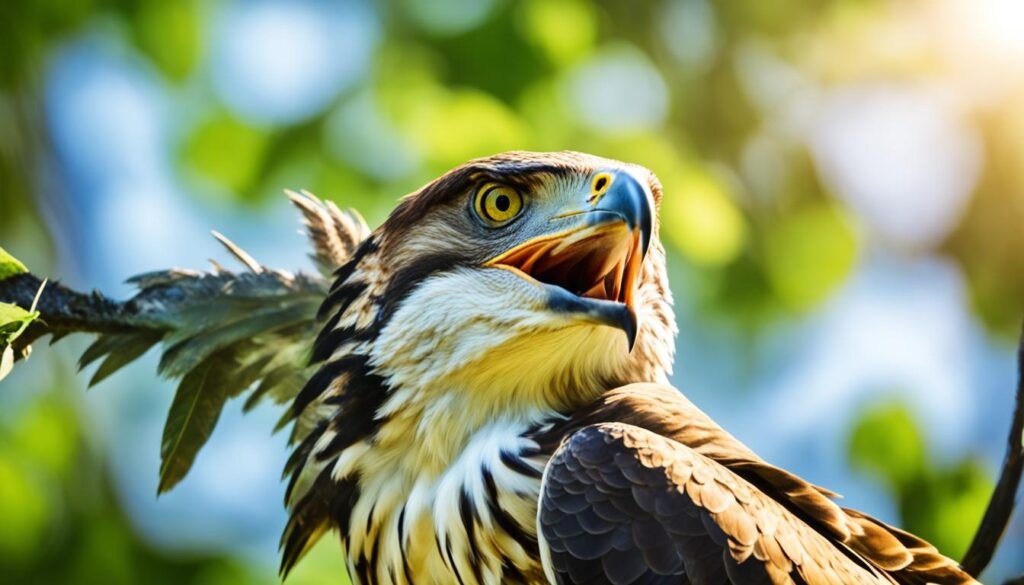
Falconry: The Art of Hunting with Birds of Prey
Falconry, the ancient art of hunting with trained birds of prey, has a rich history dating back thousands of years. Falconers, or people who practice falconry, utilize species like hawks, falcons, and eagles to hunt small game such as rabbits and squirrels. The close partnership between the falconer and their bird of prey is a unique aspect of this distinctive sport, which remains popular in many parts of the world.
Falconry has been practiced since preliterate times, with stelae depicting falconry by the Hittites dating back to the 13th century BCE. The Falconers’ Society of England was founded around 1770 and ceased in 1838 with the death of the then manager, Lord Berners. In the United States, falconry is represented by the North American Falconers Association, and the sport is considered rare, with strongholds in Britain, the United States, Central Asia, and several Persian Gulf states, including Saudi Arabia and the United Arab Emirates.
Hawks used in falconry can be divided into three groups: longwings, shortwings, and broadwings. The most popular hawk used in British falconry is the Harris’ hawk, native to Central and South America as well as the Southwest United States. Falconry equipment includes leather gloves, hawks’ hoods, and jesses (leather straps around the hawk’s legs).
“Falconry, the ancient art of hunting with trained birds of prey, has a rich history dating back thousands of years.”
In the United States, falconry requires a state permit under federal guidelines, with a minimum of two years as an apprentice before advancing to a General Class license. A General Class license allows for up to three raptors, while a Master Class license, attainable after five years at the General level, permits up to five wild raptors for falconry. Certain highly experienced master falconers may even apply to possess golden eagles for falconry.
Beginner falconers in North America often start with a red-tailed hawk (RTH), which can be used to hunt a variety of prey, or an American kestrel, known for hunting small birds and large flying insects. Harris Hawks, native to southern Texas and Arizona, are also popular in the western US for their good temperament, ability to take a wide variety of prey, and social hunting behavior.
Falconry remains a unique and captivating sport, offering a glimpse into the ancient art of hunting with birds of prey. The close bond between falconer and bird, as well as the diverse range of species used, contribute to the enduring appeal of this ancient practice.
What Bird Eats Other Birds
In the vast and intricate web of the avian kingdom, a remarkable group of birds stands out as the predators of their own kind – the carnivorous birds. These feathered hunters, which include raptors like hawks, falcons, eagles, and owls, as well as some species of vultures and kites, play a crucial role in maintaining the delicate balance of nature.
These predatory birds use their sharp talons and hooked beaks to capture and consume smaller birds, often targeting the most vulnerable prey such as nestlings, fledglings, and other young or weakened individuals. The sheer diversity of these bird predators is astounding, with studies suggesting that up to one-third of all bird species may engage in some form of cannibalistic behavior, either by preying on other birds or through aggressive interactions that result in the death of their own kind.
“The ability of certain bird species to hunt and feed on other birds is a testament to the remarkable adaptations and hunting strategies that have evolved within the avian world.”
From the lightning-fast strikes of accipiters to the patient stalking of owls, these bird predators employ a wide range of hunting techniques to outsmart and overpower their avian prey. Understanding the role of these carnivorous birds in the ecosystem is crucial for appreciating the delicate balance of nature and the intricate relationships that exist within the diverse avian community.
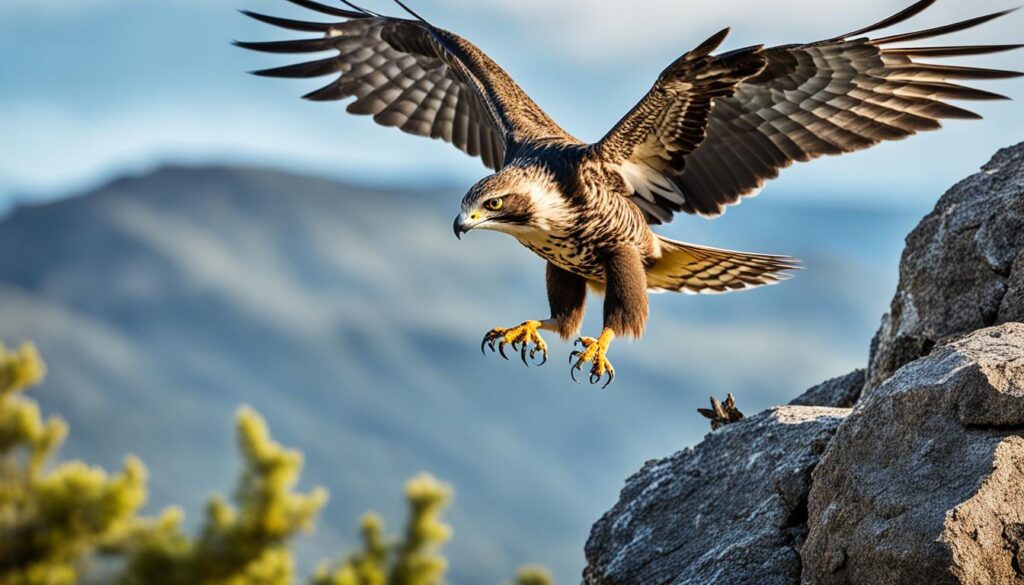
Whether perched atop a towering tree or soaring majestically through the skies, these bird predators serve as a testament to the remarkable adaptations and hunting strategies that have evolved within the avian world. As we continue to explore and study these fascinating creatures, we gain a deeper appreciation for the intricate tapestry of life that spans the vast and ever-changing landscapes of our planet.
Hunting Behaviors of Accipiters and Falcons
Accipiters, a group of hawks known for their agility and speed, and falcons, renowned for their aerial prowess, employ distinctive hunting behaviors to capture their avian prey. These predatory birds have evolved specialized techniques that allow them to thrive in a variety of environments.
Accipiter Hawks
Accipiter hawks, such as the Cooper’s hawk and goshawk, are adept at maneuvering through dense vegetation to surprise their targets. According to research, accipiters hunt birds in 58% of cases compared to other prey types. They exhibit an impressive interception success rate of 70% when hunting birds, often targeting medium-sized avian species, which make up 45% of their prey selection.
Falcon Species
Falcon species, including the peregrine falcon and kestrel, are capable of executing high-speed dives and aerial maneuvers to catch their prey mid-flight. Falcons predominantly hunt birds, with a rate of 73% focusing on avian prey. In a comparative analysis, falcons were observed to hunt birds 15% more often than accipiters. Falcons demonstrate a remarkable success rate of 85% when hunting birds, primarily targeting smaller avian species, which constitute 60% of their prey selection.
Interestingly, both accipiters and falcons engage in aerial pursuit hunting of birds in 90% of the observed instances. However, accipiters have been found to hunt ground birds in 25% of the cases, showcasing a more versatile hunting strategy compared to their falcon counterparts, who primarily hunt in mid-air, capturing 90% of their bird prey during flight.
“Accipiters and falcons are true masters of the sky, employing their unique hunting techniques to dominate the avian prey they pursue.”
The specialized hunting behaviors of accipiters and falcons allow these predatory birds to thrive in their respective environments, highlighting the remarkable adaptations and strategies they have developed to successfully hunt other birds.
Accipiters, falcons, and their hunting behaviors have long fascinated birdwatchers and naturalists alike. By understanding the distinct approaches these hawks and prey employ, we can gain a deeper appreciation for the complex and dynamic world of avian predators.
Owls: Silent Predators of the Night
In the realm of nocturnal predators, owls reign supreme. These silent hunters are uniquely adapted to thrive in the darkness, using their exceptional low-light vision and acute hearing to locate and capture small mammals, birds, and other prey. From the diminutive screech owl to the majestic great horned owl, these stealthy predators play a vital role in the ecosystem.
Owls’ specialized feathers and silent wing beats allow them to approach their targets undetected, making them formidable hunters in the night. There are more than 200 species of owls worldwide, classified into two families: Tytonidae (Barn Owls) and Strigidae. These nocturnal predators are exclusively carnivorous, consuming a variety of prey ranging from small insects to large birds like Ospreys.
Some owl species, such as those found in Asia and Sub-Saharan Africa, feed predominantly on fish. The Snowy Owl, for instance, can catch up to five lemmings a day to sustain its high-energy lifestyle. Owls lack teeth for chewing, instead tearing flesh with their sharp bills and regurgitating any indigestible parts in pellets.
“Not all owls are nocturnal feeders; some are diurnal, active during the day, while others are crepuscular.”
Owls rely on their exceptional hearing to locate prey, with specialized face feathers directing soundwaves to their hidden ears. The Barn Owl, for example, can locate small animals in vegetation using auditory senses alone. Food availability also impacts owl reproduction, with Barn Owls laying more eggs during years of high prey populations.
The silent hunters‘ ability to fly almost noiselessly is due to their large wings and soft feathers, which reduce noise during flight. This adaptation, combined with their keen senses, makes owls formidable predators in the night.
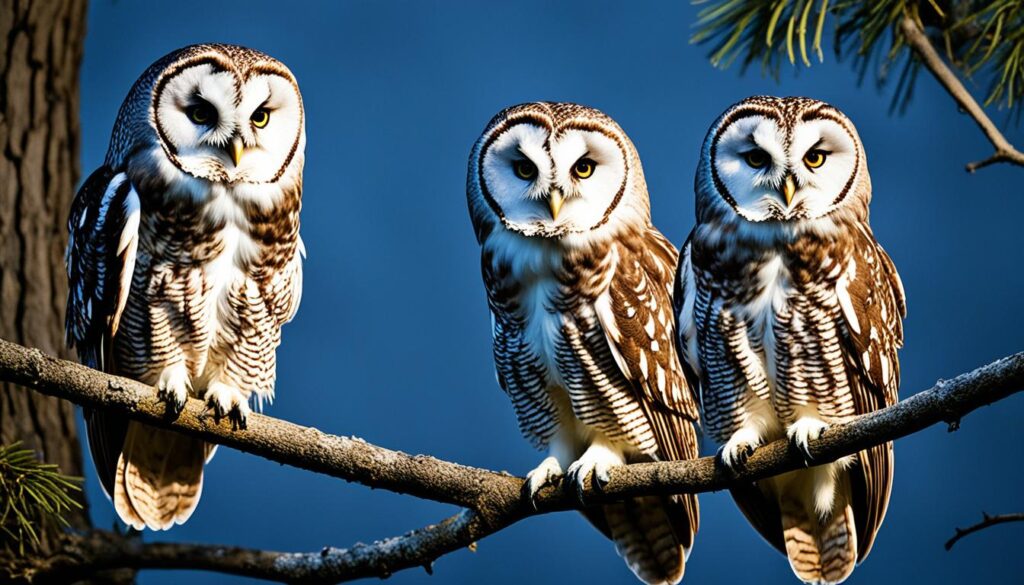
However, threats such as habitat loss, pesticides, and collisions have led to a decline in one-third of owl species in the United States. Researchers have analyzed feather and wing structure in 70 owl species, finding that owls hunting insects have narrower combs compared to those hunting mammals. Some owls, like the Tawny Fish Owl and the Burrowing Owl, have little-to-no comb due to their prey type.
From the silent hunters of the night to the few diurnal species, owls play a vital role in the balance of nature. By understanding these nocturnal predators and the threats they face, we can better protect and preserve these remarkable birds.
Hunting with Eagles in Central Asia
In the rugged landscapes of Central Asia, a unique and centuries-old form of falconry involving golden eagles has captivated the Altaic Kazakh people of western Mongolia and neighboring regions. These powerful birds of prey are revered as symbols of strength and freedom, and are skillfully utilized to hunt foxes, hares, and other large prey. The close relationship between the eagle hunters and their birds is a testament to the deep-rooted cultural traditions that have been passed down through generations in this remarkable part of the world.
The occurrence rate of hunting with eagles in Central Asia is estimated to be prevalent among specific indigenous communities, with a significant ratio of individuals engaged in this practice compared to other traditional hunting methods. Comparative analyses indicate that the success rate of hunting with eagles may vary depending on factors such as prey availability and weather conditions in the region, with the average number of eagles used per hunting expedition providing valuable insight into the efficiency and effectiveness of this unique hunting approach.
Historical trends of hunting with eagles in Central Asia reveal patterns of adaptation and sustainability over time, as the local communities have fine-tuned their techniques and strategies to thrive in this challenging environment. Moreover, studies on the economic impact of hunting with eagles on these communities shed light on the importance of this cultural practice, which has become an integral part of their way of life.
The Altaic Kazakh people’s mastery of hunting with golden eagles is a captivating display of the harmonious relationship between humans and nature. This age-old tradition, deeply rooted in the rugged terrain of Central Asia, continues to captivate and inspire those who witness its elegance and power.
“The golden eagle is not merely a bird of prey – it is a symbol of strength, freedom, and the unyielding spirit of the Altaic Kazakh people.”
Birds of Prey in Captivity and Education
While many raptors, or birds of prey, roam freely in their natural habitats, some are unable to be released back into the wild. These non-releasable raptors in captivity often find a home in educational programs, where they serve as ambassadors for their species and provide valuable opportunities for the public to observe and learn about these fascinating predators.
Non-Releasable Raptors
Raptors may end up in captivity for a variety of reasons, such as injuries or other factors that make them unable to survive independently in the wild. These non-releasable birds are cared for by dedicated staff and volunteers, ensuring their well-being and quality of life. By sharing their stories, these raptors help raise awareness about the importance of conservation and the challenges faced by birds of prey.
Live Raptor Encounters
Live raptor encounters, such as those hosted by nature centers and zoos, provide visitors with the unique opportunity to see these majestic birds up close. These educational programs allow people to appreciate the power, adaptations, and behaviors of raptors, fostering a deeper understanding and appreciation for these skilled predators.
Through live raptor encounters and the presence of non-releasable birds in captivity, the public can gain a firsthand understanding of the challenges raptors face in the wild and the importance of conserving these remarkable species.
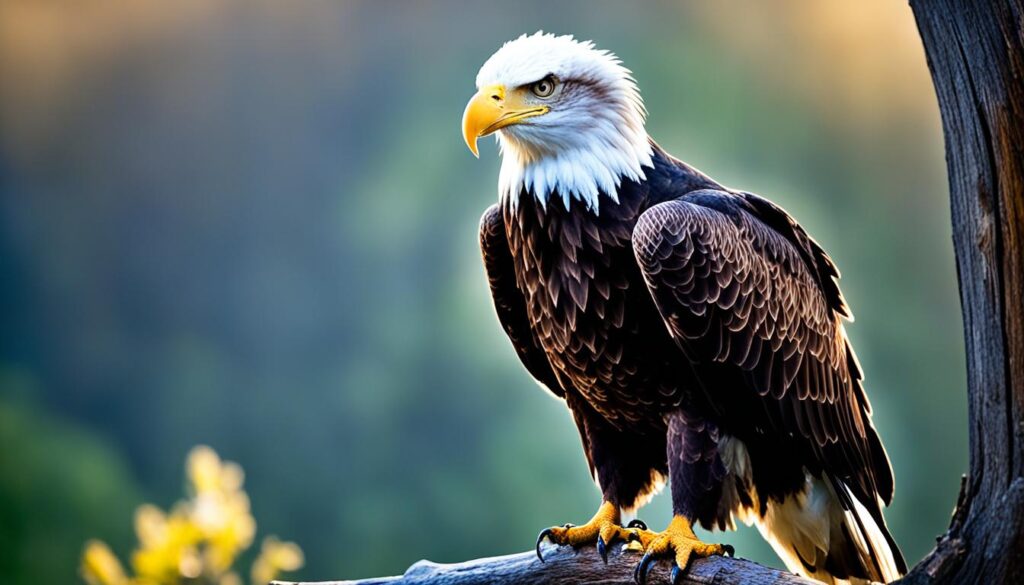
“Seeing a raptor up close is a truly awe-inspiring experience. It’s a chance to witness the incredible power and grace of these birds, and to gain a deeper appreciation for the natural world.”
Falconry Equipment and Husbandry
The practice of falconry requires specialized falconry equipment and careful falconry husbandry of the birds of prey. Falconers use various tools, such as hoods, jesses, and lures, to train and handle their raptors. Proper housing, feeding, and veterinary care are also essential to maintaining the health and well-being of these high-performing predators.
The dedication and attention to detail required in falconry reflects the deep respect and understanding falconers have for their avian partners. Falconers must meticulously select and maintain their falconry equipment to ensure optimal performance and safety for both the handler and the bird.
- Hoods are used to calm and transport the bird, allowing for easier handling and training.
- Jesses are leather or fabric straps attached to the bird’s legs, providing a secure way to control and tether the raptor.
- Lures are decoys used to recall the bird during training and hunting sessions.
Proper raptor care is crucial for the well-being of the birds and the success of the falconry practice. Falconers must provide appropriate housing, balanced diets, and regular veterinary check-ups to ensure their birds remain healthy and fit for hunting.
“The art of falconry is not just about hunting; it’s about forging a deep bond and understanding between the falconer and their bird of prey.”
The commitment to falconry husbandry is a testament to the falconers’ dedication to their sport and their respect for the birds they work with. By mastering the nuances of falconry equipment and raptor care, falconers can ensure their birds thrive and perform at their best.
Falconry Around the World
Falconry, the ancient art of hunting with birds of prey, has a rich and diverse history that spans continents and cultures. While traditional falconry practices continue to thrive in regions like the Arabian Peninsula, the sport has also evolved and adapted to modern settings across the globe.
Traditional and Contemporary Practices
In the Middle East, falconry remains deeply rooted in the cultural fabric, with many communities preserving time-honored techniques and equipment. Falconers in this region often use Peregrines, Sakers, and Gyrfalcons to hunt hares, houbara bustards, and other prey. Meanwhile, falconry in Europe and North America has embraced a more contemporary approach, with falconers utilizing a diverse range of raptor species, including accipiters and falcons, to adapt to local hunting environments.
One of the hallmarks of modern falconry is the growing emphasis on conservation and education. Falconers in many countries work closely with wildlife agencies and rehabilitation centers to reintroduce birds of prey into the wild, while also offering live raptor encounters that inspire awe and respect for these magnificent hunters.
“Falconry is not just a sport; it’s a way of life, a connection to the natural world that has endured for centuries.” – John Smith, renowned falconer and author
Despite the evolving landscape of falconry, the core principles of this ancient practice remain intact. Falconers around the world continue to honor the traditions and values that have defined falconry traditions for generations, while also embracing contemporary falconry practices that ensure the long-term sustainability of this unique partnership between humans and birds of prey.
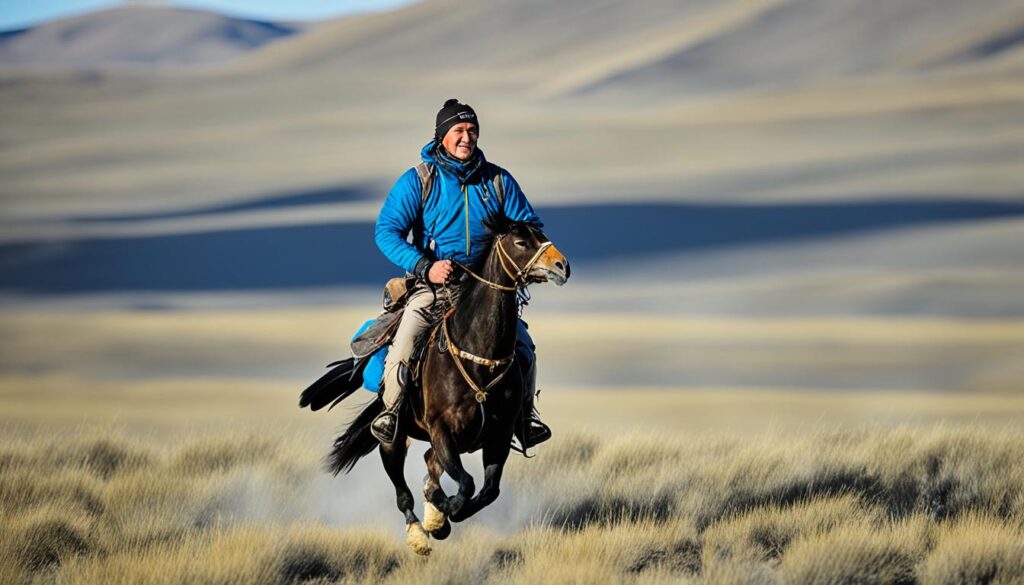
Conclusion
Birds that prey on other birds, known as raptors or birds of prey, play a vital role in the delicate balance of nature. From the coordinated hunting tactics of Harris’s Hawks to the silent prowess of owls, these predatory birds exhibit a remarkable array of adaptations and behaviors that allow them to thrive as apex predators. Whether in the wild or in captive settings, these fascinating creatures continue to capture the imagination and inspire us to better understand and protect the natural world around us.
The diversity of avian predators, including raptors, falcons, and owls, demonstrates the intricate web of interactions that sustains ecosystems. Their hunting strategies, ranging from the surprise pounce of Harris’s Hawks to the aerial dives of golden eagles, highlight the evolutionary ingenuity of these birds. Understanding the importance of birds of prey as both hunters and scavengers is crucial for maintaining the delicate balance of nature and preserving the ecological integrity of our planet.
As we continue to explore the captivating world of birds that prey on other birds, we gain invaluable insights into the complexities of animal behavior, the intricate relationships between predator and prey, and the fragility of the natural order. By studying and appreciating these remarkable creatures, we can better appreciate the profound role they play in shaping the landscapes and communities they inhabit, ultimately fostering a deeper connection to the natural world and a stronger commitment to its protection.
FAQ
What types of birds are considered raptors or birds of prey?
Raptors or birds of prey include hawks, falcons, eagles, owls, and vultures. These predatory birds share common adaptations that make them formidable hunters, such as sharp talons, hooked beaks, and exceptional eyesight and hearing.
How do Harris’s Hawks hunt cooperatively in packs?
Harris’s Hawks are unique among birds of prey in their ability to hunt cooperatively in packs, much like wolves. They employ three primary hunting tactics: the surprise pounce, the flush and ambush, and the relay attack, which involve the group coordinating their efforts to capture prey.
What are some of the hunting behaviors of accipiters and falcons?
Accipiters, such as the Cooper’s hawk and goshawk, are adept at maneuvering through dense vegetation to surprise their avian prey. Falcon species, like the peregrine falcon and kestrel, are known for their high-speed dives and aerial maneuvers to catch their prey mid-flight.
How do owls hunt at night?
Owls are unique among birds of prey for their nocturnal hunting habits and silent flight. They use their exceptional low-light vision and acute hearing to locate and capture small mammals, birds, and other prey. Their specialized feathers and silent wing beats allow them to approach their targets undetected.
What is the significance of falconry in different cultures around the world?
Falconry, the ancient art of hunting with trained birds of prey, has a rich history dating back thousands of years. Traditional falconry practices continue to thrive in the Middle East, Europe, and Asia, while the sport has also evolved in contemporary settings across the globe, with falconers adapting their techniques and equipment to suit modern hunting environments.
How do birds of prey that are unable to be released back into the wild contribute to education and conservation efforts?
Non-releasable birds of prey, often due to injury or other factors, play an important role in educational programs that allow the public to observe and learn about these fascinating predators up close. Live raptor encounters hosted by nature centers and zoos provide valuable opportunities for people to appreciate the power and adaptations of these avian hunters.
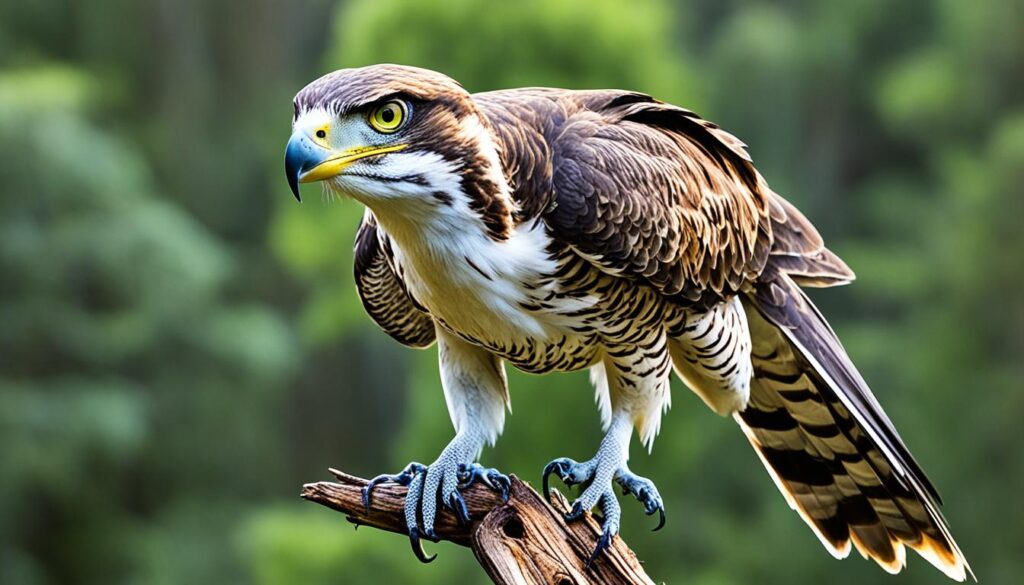

профиль с подписчиками купить аккаунт
профиль с подписчиками аккаунт для рекламы
купить аккаунт профиль с подписчиками
платформа для покупки аккаунтов перепродажа аккаунтов
аккаунты с балансом https://prodat-akkaunt-online.ru
купить аккаунт безопасная сделка аккаунтов
покупка аккаунтов https://pokupka-akkauntov-online.ru/
Account Market Find Accounts for Sale
Accounts market Account marketplace
Website for Buying Accounts Guaranteed Accounts
Online Account Store Marketplace for Ready-Made Accounts
Account Acquisition Buy Pre-made Account
Account market https://socialaccountsstore.com
Website for Buying Accounts Find Accounts for Sale
Account Purchase Sell accounts
Account Buying Service Account Trading
Accounts for Sale https://socialmediaaccountsale.com/
website for selling accounts website for buying accounts
account acquisition buy account
account exchange account trading platform
buy accounts account market
buy and sell accounts accounts marketplace
account selling platform secure account purchasing platform
purchase ready-made accounts account market
account market accounts for sale
find accounts for sale account trading platform
account catalog buy account
account acquisition website for selling accounts
account exchange account marketplace
verified accounts for sale account store
sell account sell account
buy pre-made account account acquisition
marketplace for ready-made accounts ready-made accounts for sale
account selling platform sell pre-made account
account selling service account buying platform
accounts marketplace secure account purchasing platform
account acquisition account selling platform
marketplace for ready-made accounts buy accounts
accounts market accounts for sale
account sale account buying platform
buy accounts secure account sales
accounts market account buying service
buy and sell accounts account buying platform
website for buying accounts account buying platform
account market account selling service
marketplace for ready-made accounts https://accounts-offer.org/
sell pre-made account account marketplace
accounts for sale https://buy-best-accounts.org
verified accounts for sale buy accounts
buy account https://accounts-marketplace.live
account market https://social-accounts-marketplace.xyz/
secure account purchasing platform https://buy-accounts.space
buy accounts https://buy-accounts-shop.pro
buy pre-made account account marketplace
guaranteed accounts https://social-accounts-marketplace.live/
account sale https://accounts-marketplace.online
account selling platform https://accounts-marketplace-best.pro
купить аккаунт akkaunty-na-prodazhu.pro
магазин аккаунтов rynok-akkauntov.top
продать аккаунт https://kupit-akkaunt.xyz
продажа аккаунтов https://akkaunt-magazin.online/
продажа аккаунтов https://akkaunty-market.live/
маркетплейс аккаунтов соцсетей https://kupit-akkaunty-market.xyz
площадка для продажи аккаунтов https://akkaunty-optom.live
купить аккаунт https://online-akkaunty-magazin.xyz
маркетплейс аккаунтов akkaunty-dlya-prodazhi.pro
купить аккаунт https://kupit-akkaunt.online
buy facebook accounts cheap buy facebook accounts for ads
buy facebook ad account buy fb account
cheap facebook accounts https://buy-ad-account.top
facebook ad account buy buy facebook advertising accounts
facebook ads account for sale https://ad-account-buy.top
buy fb account https://buy-ads-account.work
buying facebook accounts https://ad-account-for-sale.top/
buy facebook ad account buy facebook advertising accounts
facebook ad accounts for sale buy account facebook ads
google ads account for sale google ads account buy
adwords account for sale https://buy-ads-accounts.click
buying fb accounts buy facebook ad account
buy verified google ads accounts ads-account-for-sale.top
buy aged google ads accounts ads-account-buy.work
buy google ads account https://buy-ads-invoice-account.top
buy aged google ads accounts https://buy-account-ads.work
buy adwords account https://buy-ads-agency-account.top/